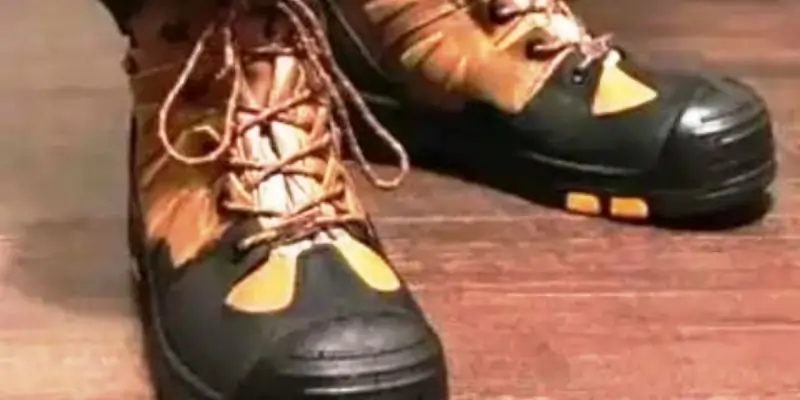Work Boots
Safety in the workplace has always been paramount, especially for marine engineers and industrial employees who face unique hazards daily. As we continue to innovate and improve, the significance of high-quality Work Boots remains critical. In 2024, advancements in technology and materials have brought safety footwear to new heights, offering unparalleled protection and comfort. Whether you’re navigating the slippery decks of a ship or the rugged terrain of an industrial site, the right pair of Work Boots can make all the difference. From reinforced toe caps and slip-resistant soles to advanced insulation and ergonomic designs, today’s safety shoes are engineered to meet the highest standards.
In this comprehensive guide, we’ll explore the Work Boots, detailing their features, benefits, and why they are indispensable for marine and industrial professionals. Equip yourself with the best footwear to ensure your safety and productivity on the job. Welcome to the ultimate guide to safety shoes in 2024, where tradition meets innovation.

What are Work Boots for Men?
Work boots are essential footwear for men engaged in physically demanding or hazardous work environments. Designed to offer protection, durability, and comfort, these boots are a must-have for anyone who is active in their work or daily life. They shield your feet from accidents, slips, and falls, ensuring safety and stability in various conditions.
Why You Need Work Boots
Whether you’re working on a ship, construction site, or in any industrial setting, the likelihood of encountering falling objects, such as dirt, rocks, and debris, is high. Work boots are built to withstand such impacts, often featuring reinforced toe caps to protect against heavy objects. Additionally, their sturdy construction helps prevent injuries from sharp or rough surfaces.
Key Features of Work Boots
One of the critical features of quality work boots is their traction soles. These soles are designed to provide excellent grip on various surfaces, reducing the risk of slips and falls. This is particularly important in wet or oily environments, common in marine and industrial settings. The enhanced traction helps maintain balance and stability, which is crucial for safety and productivity.
Comfort and Ergonomics
Modern work boots also prioritize comfort and ergonomics. They are designed to support the foot’s natural shape, reducing fatigue during long hours of wear. Advanced materials and cushioning technologies help absorb shock and provide all-day comfort, making them suitable for extended use.
What are the Benefits of Using Work Boots for Men?
Work boots are an indispensable part of personal protective equipment for men working in hazardous environments. Designed to provide comprehensive protection and comfort, work boots offer numerous benefits that extend beyond mere compliance with safety standards. Here are some of the key advantages of using work boots for men:
1. Protection from Physical Injuries
Impact Resistance: Work boots often feature reinforced toe caps made from steel, composite materials, or aluminum, which protect the feet from heavy falling objects and compression injuries.
Puncture Protection: Many work boots come with puncture-resistant midsoles that prevent sharp objects, like nails or metal shards, from penetrating the sole and injuring the foot.
Slip Resistance: Work boots are equipped with slip-resistant soles that provide superior traction on wet, oily, or uneven surfaces, significantly reducing the risk of slips, trips, and falls.
2. Electrical Hazard Protection
Insulation: For those working in environments with electrical hazards, work boots offer electrical insulation, which can prevent electric shocks by providing a barrier against live wires and electrically charged equipment.
Conductive and Anti-static Options: In settings where static discharge or the build-up of static electricity can be dangerous, specially designed work boots help in dissipating static electricity, protecting both the wearer and sensitive electronic equipment.
3. Chemical and Thermal Protection
Chemical Resistance: Certain work boots are designed to withstand exposure to harmful chemicals and corrosive substances, providing a vital layer of protection for workers in chemical plants and laboratories.
Heat and Cold Resistance: Work boots can also offer thermal insulation, protecting feet from extreme temperatures, be it in a hot manufacturing plant or a cold storage facility.
4. Enhanced Comfort and Ergonomics
Support and Cushioning: Modern work boots are designed with ergonomic features that support the natural shape of the foot, reducing strain and fatigue during long work hours. Cushioning insoles and padded collars enhance comfort, making them suitable for prolonged use.
Breathability and Moisture Control: Many work boots incorporate breathable materials and moisture-wicking linings to keep feet dry and comfortable, preventing issues like blisters and fungal infections.
5. Improved Productivity
Reduced Fatigue: By providing proper support and comfort, work boots help reduce foot fatigue and overall discomfort, allowing workers to stay focused and productive throughout their shift.
Enhanced Mobility: The right pair of work boots can improve mobility and agility, enabling workers to move more freely and efficiently, which is particularly important in dynamic and fast-paced environments.
6. Compliance with Safety Regulations
Meeting Standards: Work boots are designed to comply with various safety standards and regulations, ensuring that workplaces adhere to legal requirements and provide a safe environment for their employees.
How Do Work Boots for Men Work?
Work boots for men are engineered to provide maximum protection, support, and comfort in demanding work environments. They are meticulously designed to address various safety concerns, ensuring that workers can perform their tasks efficiently and safely. Here’s a detailed look at how work boots for men work to keep you safe and comfortable on the job:
Protection Features
Reinforced Toe Caps: One of the most critical components of work boots is the reinforced toe cap, typically made from steel, composite materials, or aluminum. These toe caps protect your feet from heavy impacts and compression, safeguarding against falling objects or accidental kicks.
Puncture-Resistant Midsoles: Many work boots include puncture-resistant midsoles made from tough materials like Kevlar or steel. These midsoles prevent sharp objects, such as nails or glass, from penetrating the sole and causing injuries to the foot.
Slip-Resistant Soles: Work boots are equipped with slip-resistant outsoles designed to provide excellent traction on various surfaces, including wet, oily, or uneven terrain. This feature significantly reduces the risk of slips, trips, and falls, which are common in many work environments.
Electrical Hazard Protection
Insulating Materials: For workers exposed to electrical hazards, work boots often feature insulating materials that protect against electric shocks. These materials create a barrier between the foot and any live electrical sources, reducing the risk of injury.
Anti-Static and Conductive Options: In environments where static discharge can pose a danger, work boots may have anti-static or conductive properties to dissipate static electricity, protecting both the wearer and sensitive electronic equipment.
Chemical and Thermal Protection
Chemical-Resistant Materials: Work boots designed for chemical exposure use materials that can withstand corrosive substances, preventing chemical burns and other injuries. These boots are essential for workers in laboratories, chemical plants, and similar settings.
Thermal Insulation: To protect against extreme temperatures, work boots often include thermal insulation. This feature keeps feet warm in cold environments and cool in hot conditions, ensuring comfort and safety regardless of the work setting.
Support and Comfort
Ergonomic Design: Modern work boots are ergonomically designed to support the natural contours of the foot, reducing strain and fatigue. Features such as arch support, cushioning insoles, and padded collars contribute to overall foot health and comfort during long hours of wear.
Breathable Materials: Many work boots incorporate breathable materials and moisture-wicking linings to keep feet dry and comfortable. This helps prevent blisters, fungal infections, and other foot issues that can arise from prolonged wear.
Enhanced Durability
High-Quality Construction: Work boots are built to last, using durable materials and robust construction techniques. This durability ensures that the boots can withstand the harsh conditions of various work environments, providing long-term protection and value.
Materials for the different parts of Work Boots
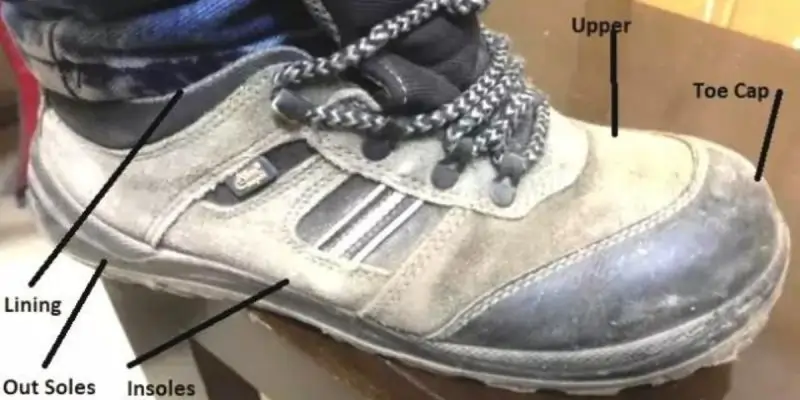
| Part | Material | Description |
|---|---|---|
| Toe Cap | Steel | Provides high impact and compression resistance, offering robust protection against heavy objects and sharp impacts. |
| Composite Materials | Made from non-metallic materials like Kevlar, carbon fiber, or fiberglass, offering lightweight protection with resistance to both impact and electrical hazards. | |
| Aluminum | Lightweight metal that provides strong protection while being less heavy than steel, suitable for long hours of wear. | |
| Upper | Leather | Durable and flexible material offering abrasion resistance, comfort, and breathability. |
| Synthetic Leather | Offers similar properties to natural leather with enhanced resistance to chemicals and water, often more lightweight. | |
| Mesh Fabric | Provides excellent breathability and flexibility, commonly used in lightweight work boots for added comfort. | |
| Lining | Moisture-Wicking Fabric | Keeps feet dry by drawing moisture away from the skin, reducing the risk of blisters and infections. |
| Thermal Insulation | Keeps feet warm in cold environments, often made from materials like Thinsulate or wool. | |
| Anti-Microbial Fabric | Prevents the growth of bacteria and fungi, maintaining foot hygiene and reducing odors. | |
| Insole | EVA Foam | Lightweight and cushioned material that provides excellent shock absorption and comfort. |
| Memory Foam | Conforms to the shape of the foot for personalized comfort and support, reducing foot fatigue. | |
| PU Foam | Offers durability and cushioning, maintaining shape and support over time. | |
| Outsole | Rubber | Provides excellent slip resistance and durability, ideal for various terrains and conditions. |
| TPU (Thermoplastic Polyurethane) | Combines flexibility, abrasion resistance, and strong grip, often used for lighter and more flexible outsoles. | |
| PU (Polyurethane) | Lightweight and durable material that offers good traction and is resistant to oil and chemicals. |
Types of Protection by Safety Shoes
Protection against falling or rolling objects
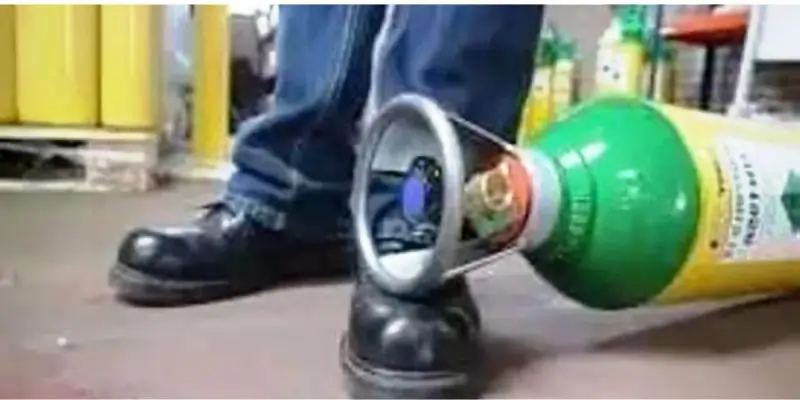
The maximum common cause of foot injury in the workplace is the falling of heavy objects. Safety footwear is designed to protect the foot from the severe impact of such incidents. The reinforced toe cap offers critical protection, preventing the foot from being crushed under the weight of the object.
Safety footwear acts as a savior for those working in the marine industry, heavy steel production, and construction sectors. These dynamic industries are fraught with hazards, with people and objects constantly moving around. An object might roll on the ground, or something might suddenly drop onto your feet. In such environments, steel toe safety footwear is the best protection one can have. These boots are designed to absorb and distribute the impact force, preventing fractures and major injuries. By wearing safety footwear, workers can ensure their feet are well-protected, allowing them to focus on their tasks without fear of injury.
Protection against skid
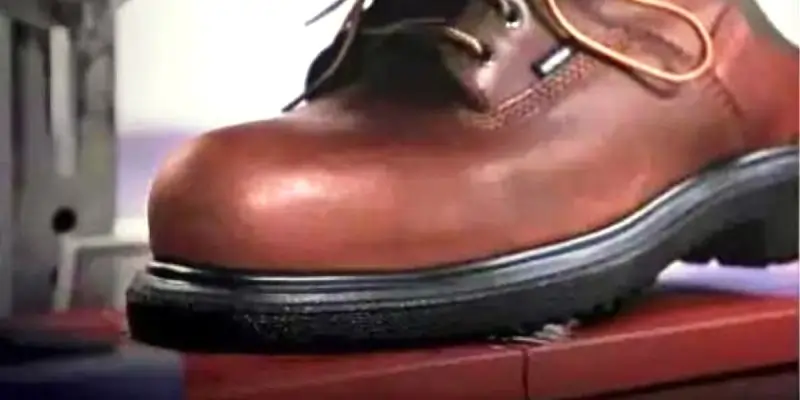
Workplace injuries or accidents can happen for numerous reasons, and slips or falls are among the most common. To protect yourself from these incidents, your shoes need to have anti-skid properties. In areas where there is a risk of slipping due to heavy viscosity spills, an outsole with anti-skid properties is essential to prevent injuries caused by slippage.
Anti-Skid Outsoles: Safety shoes designed with anti-skid outsoles offer superior traction on slippery surfaces. These outsoles are typically made from high-grip materials such as rubber, featuring tread patterns that enhance grip and stability. The deep grooves and channels in the tread design help to disperse liquids, preventing a slick layer from forming between the shoe and the ground.
Protection in Lubricant and Water Environments: When working with lubricants or water, it is crucial to wear safety shoes with anti-skid properties. These shoes help maintain footing and balance, reducing the risk of slipping on wet or oily surfaces. The enhanced grip ensures that workers can move confidently and safely, even in challenging conditions.
Safety for Heights and Climbing: For people working at heights who frequently climb ladders or stairs, anti-skid safety shoes are indispensable. Falling from heights can cause severe injuries, and having shoes that provide reliable traction can prevent such accidents. The anti-skid features ensure that workers have a secure grip on steps and rungs, minimizing the risk of falls.
Enhanced Stability and Comfort: Anti-skid safety shoes also enhance overall stability and comfort. The combination of high-grip outsoles and cushioning systems in the midsoles reduces the force transmitted to the feet and legs, helping to maintain a firm footing. This is particularly important for long hours of work, as it reduces fatigue and the likelihood of accidents.
Protection against chemicals
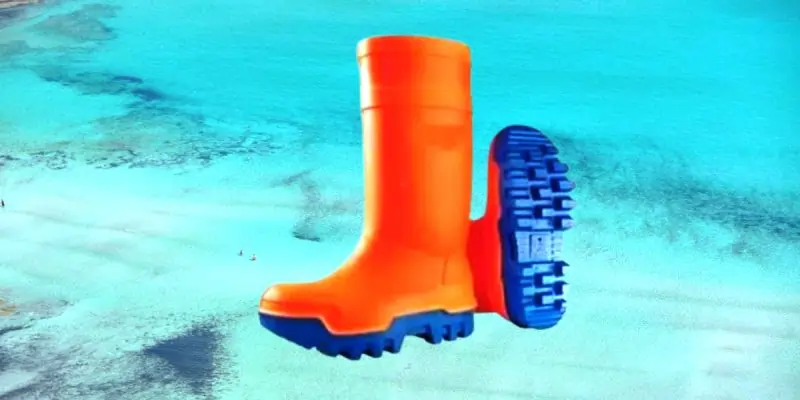
Another important function of a safety shoe is to protect the feet from chemicals. When working in a chemical or cement industry with a lot of chemical spilling all over the floor a worker cannot risk wearing simple shoes. Such safety shoes need to have a pure rubber thick sole.
There are many chemicals that can be dangerous to your health, especially when they fall on your feet. Always use safety shoes when working in the chemical industry to protect yourself from chemicals.
Protection Against Electrocution

Working in a place with an accumulation of static electricity may cause shocks; using a pair of shoes with conductive properties will minimize the amount of static electricity in the body. Shocks can be due to the accumulation of static current of when working on a live wire with current flowing through it. Safety shoes for such professionals are made from non-conductive materials such as leather, rubber, etc. In areas of static current, anti-static materials are used to reduce the accumulation of static current on the body and prevent electric sparks.
Vice versa, a person, working directly with electricity will have to have the option of non-conductive shoes to prevent the electric charges from entering the body.
Protects against cuts
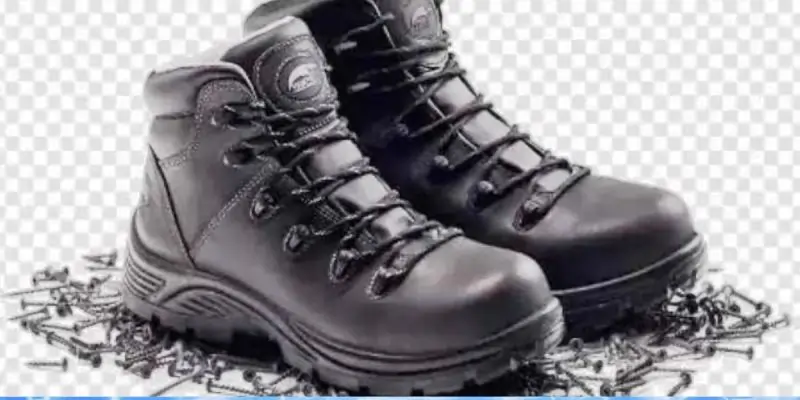
Working with cutting machines such as chainsaws or logging machines, it is mandatory to use proper footwear with cut-resistant properties to protect against cutting injuries. The cut resistant material will not let the sharp object get in touch with your foot and damage it. The hard outer body and the steel toe acts as a shield for the foot.
Tiredness prevention properties
Prevent Tiredness is a brand that specializes in safety shoes. These shoes provide protection and comfort that does not let you feel tired. If you are working at a construction site or need to stand on concrete surfaces for hours on end, your feet, back and gradually your whole body will grow tired. Things can get worse if this is a daily task and you are not wearing the safety shoes that you should be.
Symbols and Classifications of Safety Shoe
| Symbol | Classification |
| SB | Basic level for safety shoe-Toe cap capable of withstanding impact of 200 joules |
| S1 | A toe cap capable of withstanding an impact up to 200 joules and a penetration-resistant midsole. |
| S2 | Fully enclosed heel, anti-static properties, and can withstand an impact of 200 joules |
| S3 | Fully enclosed heel, anti-static properties, water resistant, and can withstand an impact of 200 joules |
| S4 | Outsole with rubber or polymeric, upper with anti-static properties, energy absorbing and 200 joule toe cap protection |
| S5 | Same as S4 plus penetration resistant. |
| SBP | Outsole with rubber or polymeric, upper with anti-static properties, energy absorbing, and 200 joule toe cap protection |
| S1P | As with S2 but with an additional penetration-resistant midsole. |
| S2P | The same as the S1 but with an additional penetration-resistant midsole. |
Steel Toe Shoes for Men Work Women Lightweight
These shoes are designed with the safety of your feet in mind. The shoes are made of a lightweight and durable alloy, which can help to protect your feet from falling or rolling objects, greatly enhance the safety. The composite toe shoes for men can help to protect your feet from falling or rolling objects, greatly enhance the safety. The shoes are made of a lightweight and durable alloy, which can help to protect your feet from falling or rolling objects, greatly enhance the safety.
WHITIN Men’s Steel Toe Slip Resistant Puncture Proof Safety Shoes
Your work shoes are about to be a whole lot safer with the WHITIN Men’s Steel Toe Slip Resistant Puncture Proof Safety Shoes. Offering a padded mesh collar for added comfort and a work shoe with steel toe and electrical hazard protection, this shoe is a must have for your work wear. The durable synthetic toe guard offers protection from nails and sharp objects, while the traditional lace-up style with metal eyelets protects your feet from any unwanted accidents.
Frequently Asked Questions on Safety Shoes For Men
Q: Do safety shoes come in different sizes?
A: Yes, safety shoes are available in various sizes to fit all feet comfortably.
Q: Are safety shoes suitable for outdoor work?
A: Absolutely, safety shoes are designed to provide protection in both indoor and outdoor work environments.
Q: Can I find stylish safety shoes for men?
A: Yes, you can find safety shoes with stylish designs that offer protection without compromising on looks.
Q: What types of hazards can safety shoes protect against?
A: Safety shoes can protect against hazards like falling objects, electrical shock, slips, and more, depending on their specifications.
Blog Conclusion
We hope you enjoyed our article about safety shoes for men. We know that safety shoes can be a big expense, but these are worth it. They are vital to the safety of the person working within a dangerous or strenuous environment. This is why companies provide them to employees on the job site. If you need to obtain safety shoes, please contact us and we would be more than happy to help you out.
If you are unsure where to get them, we hope that this article has given you a few ideas. If you want to get more information on safety shoes for men, you can contact us at https://marinediesel.co.in/iesel.co.in/. We hope you have had a great time reading our article, we appreciate your time and look forward to hearing from you soon!
